Image Credit: Roxul
Image Credit: Roxul Residential installation of ComfortBoard IS.
Image Credit: Residential installation of ComfortBoard IS. ComfortBoard insulation is typically installed over sheathing. However, if structural bracing is provided, ComfortBoard can be installed without exterior sheathing.
Image Credit: Roxul
Readers of this Energy Solutions blog may be aware that I’ve been critical of some of our foam-plastic insulation materials. I’ve come down hardest on extruded polystyrene (XPS), which is made both with a blowing agent that contributes significantly to global warming and with a brominated flame retardant, HBCD, that’s slated for international phaseout as a persistent organic pollutant.
So I’m always keeping an eye out for alternatives. I’ve written here about two of those alternatives that I’ve used in our own home: a cellular glass material called Foamglas with high compressive strength that works very well below-grade; and a boutique, all-natural rigid insulation material made from expanded cork.
I like both of those materials a lot, but they have two big problems: high cost and limited availability. They just won’t be able to enter the mainstream home building industry since they cost more than twice as much as XPS and polyisocyanurate and are hard to get hold of.
Enter ComfortBoard mineral wool boardstock
With this context, I was thrilled to learn recently that Roxul, a Canadian manufacturer of mineral wool (or rock wool) insulation and part of the global, Denmark-based Rockwool International, has been gaining traction with their residential ComfortBoard IS in the U.S. Plus, the company has a new, even higher-density boardstock product coming out this month for commercial applications.
Rigid boardstock mineral wool has been available in the U.S. for decades from at least four manufacturers, and it is widely used in commercial construction. But it’s never been widely available for home building.
That is changing as Roxul ramps up national distribution of ComfortBoard IS, which was first introduced about a year ago. (A few years earlier the company began national distribution of their ComfortBatt product for cavity-fill applications.)
Manufactured at Roxul’s Milton, Ontario, factory, ComfortBoard IS is third-party-certified to have a minimum recycled content of 75%, and the product can be specified with recycled content up to 93%.
ComfortBoard IS, the residential product, has a density of 8 pounds per cubic foot (pcf) and is available in four thicknesses: 1 1/4 inch, 1 1/2 inch, 2 inches, and 3 inches. The company has the capability to produce the product up to 6 inches thick — which could offer an attractive option for Passivhaus builders and those interested in deep-energy retrofits — but because thicker panels requires a special production run, those options are only available in truckload quantities.
The insulating value of ComfortBoard IS is a very respectable R-4.0 per inch. That’s lower than XPS (R-5 per inch) and polyiso (about R-6.0 per inch), but there will be no “R-value drift” (reduction in R-value over time), which occurs with foam insulation materials that rely on lower-conductivity blowing agents that slowly leak out or allow air to leak in.
Vapor permeance
A very attractive property of ComfortBoard IS is the high permeability to water vapor. A 2-inch layer of the insulation has a permeability of about 30 perms, which means it’s highly breathable. If the ComfortBoard is installed on the outside of the wall, the high permeance will allow excellent drying potential to the exterior. This approach, in which the sheathing layer provides the continuous air barrier, is gaining many fans in the building science community.
ComfortBoard IS has a textured outer surface (see photos), which may even aid moderately in the product’s drying potential (acting like a rainscreen). When asked about this, Paraic Lally, the North American Manager for Specifications at Roxul, told me that the texturing is a function of the manufacturing process and not designed to provide a rainscreen; thus, the orientation of installation is not important.
Another feature of mineral wool that I hadn’t appreciated before is the very low coefficient of thermal expansion with temperature. According to Roxul, the coefficient of thermal expansion of ComfortBoard is just 5.5 (10–6 m/m°C), compared with 80 for XPS and 120 for polyiso. In applications where temperatures fluctuate significantly (like on the outside of a wall in a cold climate) this could make a significant difference.
Availability and price
I was pleasantly surprised recently when I asked Leader Home Center in Brattleboro, Vermont, to price a number of insulation materials for a BuildingGreen report we’re revising. The contractor pricing for ComfortBoard IS came to $0.64 per board foot, compared to $0.48 per board foot for standard polyiso, $0.75 for fire-rated polyiso (Thermax), and $1.07 for XPS.
While pricing will doubtless differ in other regions and for different quantities, the fact that ComfortBoard is in the same ballpark as these other materials is great. Even after correcting for the lower insulating value (you need more thickness of ComfortBoard to achieve R-10 than with the foam plastics), Comfortboard IS locally was more affordable than XPS: roughly $1.59 per square foot at R-10 for ComfortBoard vs. $2.14/sf @ R-10 for XPS.
Dimensions and installation
Although Roxul literature shows ComfortBoard IS being available in three sizes — 24″ x 48″, 36″ x 48″, and 48″ x 96″ — it is most commonly stocked in the smaller sizes. This may be because the larger panels will be fairly heavy. At 8 pcf, a 3-inch-thick, 4′ by 8′ panel weighs 64 pounds — not an insignificant weight to wrestle into place.
To achieve a reasonably thick, 4- to 6-inch layer of exterior insulation for a deep-energy retrofit or Passivhaus wall system will require a double layer (unless you have the ability to order by the truckload). This can be an advantage because is allows overlapping the panel joints (only square-edge product is produced), but it will likely increase labor costs.
Rigid mineral wool may also take some getting used to from an installation standpoint. It can be cut with a hand saw, though I can’t (yet) report on cutting the product from personal experience. Minimum 1-inch-diameter washers or nail/screw heads are recommended for attachment, and when strapping is installed on the outside to produce a rainscreen, that strapping has to be screwed into wood studs through the insulation. Because it is mineral-fiber product, a dust mask and gloves should be used when working with it.
Commercial ComfortBoard on the way
Just as exciting as the increased availability of ComfortBoard IS is a commercial version that’s about to be introduced: ComfortBoard CIS. It is similar to the residential product, but produced at a higher density of 11 pcf. Like Comfortboard IS, it can be ordered up to 6 inches thick, but standard thicknesses will be only up to 3 inches.
While I am pleased to have used Foamglas and cork insulation on my home, I suspect that Roxul’s ComfortBoard will find its way into my next project.
Alex is founder of BuildingGreen, Inc. and executive editor of Environmental Building News. In 2012 he founded the Resilient Design Institute. To keep up with Alex’s latest articles and musings, you can sign up for his Twitter feed.
Weekly Newsletter
Get building science and energy efficiency advice, plus special offers, in your inbox.

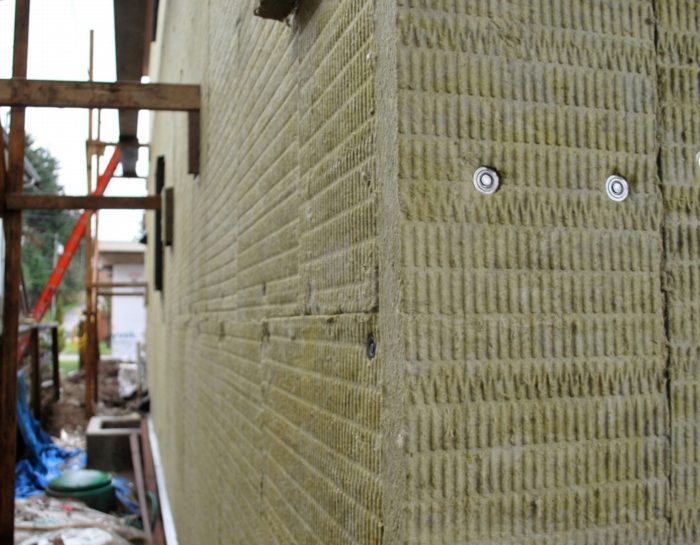




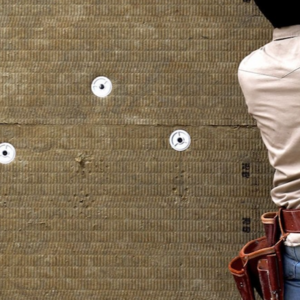
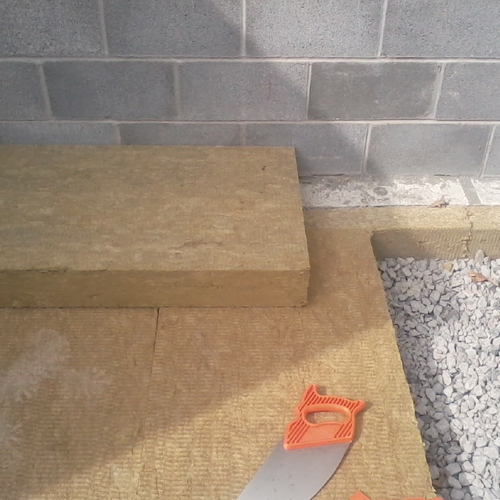
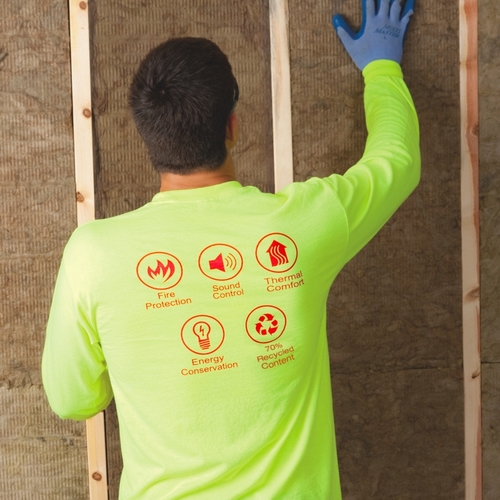
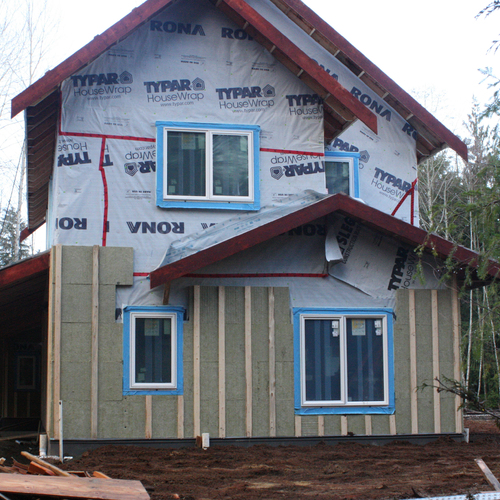






15 Comments
Usable on roofs?
Interesting product, and made close to home. I'm wondering if it can be used on roofs, in particular over a cathedral ceiling. What would the ceiling assembly consist of in that case?
It sounds great in theory but
It sounds great in theory but it's heavy and thick. How is one supposed to fasten 6" of this to the outside of a wall? I don't imagine HeadLocks would hold up to the weight of 8 pcf.
Basement Walls
I am insulating a basement in Portland Oregon. The plan was to use 2" of XPS against the concrete, and then a 2x4 or 2x6 stud wall filled with Roxul Comfort Batt. Could I use Comfortboard IS or CIS in place of the XPS, or do I still need a vapor impermeable material like XPS or Foamglas against the wall in the condensation zone?
Response to Adam Liberman
Adam,
You can use dense mineral wool insulation to insulate the exterior of a concrete foundation wall, but I don't recommend that you install it on the interior, because it is so vapor-permeable. It will allow warm, moist interior air to contact the cold concrete, where the moisture will condense. You don't want that.
You should use a rigid foam insulation or closed-cell spray foam insulation against the concrete if you want to install your insulation on the interior.
More information here: How to Insulate a Basement Wall.
Great alternative to foam
It has baffled me for a long time how foam insulation can be so toxic and yet have gained such a reputation as a green building material.
The houses we work in and live in are full of a long list of products that were designed and marketed with reckless disregard for human health, and the price we pay is higher than we realize: lead paint, asbestos, formaldehyde, copper chromium arsenate, PCBs, vinyl, and so on. When you look at the science on flame retardants used in foam, you realize it's as bad as anything on that list. To my mind the green building community hasn't done a good job pushing back against products that ask us to sacrifice health for cheap and easy--a false choice ultimately.
In rehabbing my own old house I wanted to avoid adding foam to the long list of toxins I already have to deal with, and I experimented with Roxul DrainBoard on the inside of my attic cathedrals (my supplier for some reason couldn't get ComfortBoard.) Apparently DrainBoard is almost the same as ComfortBoard, although dimensions are slightly different and its intended use is below grade.
The 4X6X1" sheets were a bit heavy to work with, but not too bad. It cuts easily with a serrated bread knife, and no fishy offgassing. Definitely want a mask and gloves--it's itchy. I hung it with the ring shank nails and plastic washers that are usually used for foam. And as you say, the cost per bf was surprisingly competitive. The fact that it's inherently non-combustible and has such high permeance are big advantages as well. I really hope this stuff takes off--thanks for highlighting it.
Cutting Mineral Wool Board Products
I installed 1-1/4" Roxul "Drainboard" (sim to "comfortboard", but more readily stocked at the time) on all the exterior walls of my house. It was easiest to cut it with a serrated kitchen bread knife. The same is true for the "comfortbatt" products. Don't bother trying to cut mineral wool with a utility knife like you would fiberglass batt, it just tears it up.
With wood-frame construction in wet northwest climates, vapor-permeable air/weather barriers and the addition of exterior mineral wool board insulation is where it's at!
Cutting Roxul
Wife was not happy about it, but I used the electric serrated carving knife. Cuts like butter!
cannot find locally in Iowa
I am a do it yourselfer and have not found Comfortboard at the local big box stores - Home Depot, Lowes, Menards. Hope when the US plant begins operation it will be more widely available.
Response to Adam and Eric and a question
I called Roxul in Ontario and they said that ComfortBoard should be used above grade, and DrainBoard below grade, as they hadn't been tested the reverse of that. The problem might be in finding both of these products, as both the 2 3/8" and the 3" are non-stock items, so ordering would require half a truckload.. In Minnesota they said that Prime Source (1-800-829-2120) supplies Home Depot and Lowes. I called Prime Source and they said they can get ComfortBoard in 3" thickness in 2' x 4' or 3' x 4' boards (24 sf min order from HD), but don't show DrainBoard or the 2 3/8" size as available. Roxul said that they only have 2 3/8" and not 3". My 3 part question, then, is where might I get DrainBoard in lesser amounts than half a truckload or has anyone used ComfortBoard below grade, and how much is in a half a truckload?
Response to Stephen on Availability
Hi Stephen,
I'm in the process of insulating both above an below grade on a project outside of Chicago and I received the same story from Home Depot and Prime Source. The two things that I want to share that may help are
1) Thermafiber makes a similar product and their lead time to Chicago out of central Indiana is 10 days. Their RainBarrier HD board is available from a local distributor to lumber yards and you may try going to their website and finding out if anyone in Minnesota stocks it.
2) I was able to find a limited amount of mineral wool insulation at a local commercial insulation supplier who stocks it for insulating commercial HVAC equipment. They didn't have enough in stock to do the whole house but they did have enough for the foundation and to get me by until the Thermafiber order comes in.
Response to Benjamin
Benjamin, thanks for the info. Sorry it took so long to respond. I haven't been on GBA for a while. Is the below grade portion of your project concrete? If so, how did you fasten the insulation to the below grade portion of the project? I am concerned about two things when fastening to concrete below grade - penetrations of the waterproofing by fasteners, and thermal conductivity of the fasteners.
Availability
Anyone had any luck sourcing mineral wool board for residential exterior sheathing insulation? I'm currently refurbishing a stucco shell (poorly installed, no expansion gaps, cracking, 20 y/o) and have the opportunity to increase the currently 1" XPS to ~3" whatever (there is a really big fir/airgap behind the XPS if you are wondering how I could go from 1" to 3"). I've looked at polyiso but read the recent GBA article about polyiso and cold temperature conductivity (this is climate zone 5b) and would be interested in mineral wool board. However, my efforts to source Roxul via Home Depot/PrimeSource have failed as it is only available by the semi truck load. While I might use that eventually, I'm planning to do this refurb one side a year. Any suggestions re sourcing it would be appreciated.
Response to Keith H
Keith,
Yes, some homeowners have had luck purchasing Roxul mineral wool insulation. Here are links to stories about two residential projects:
Wrapping an Older House with Rock Wool Insulation
Installing Roxul Mineral Wool on Exterior Walls
You may wish to contact Roxul to ask about distributors in your area. Here is the contact information:
Roxul, Inc.
420 Bronte Street South, Suite 105
Milton, Ontario L9T 0H9
Canada
905-878-8474
800-265-6878
Fax: 905-878-8077
Cost per R - update
The article notes that to get the same R value, you'd need to install thicker glasswool boards than foam boards, adding to costs.
That is only true for initial R value.
Aged R values are nearly identical.
It is time the building and real estate industry stops making short term decsions.
Buildings, to best leverage the embedded energy and carbon in them must be built to last.
Materials and methods need be based on functionality decades down the line!
Powerwool works well too http://www.powerwoolinsulation.com . You can find most of this stuff at http://www.warehoos.com
Log in or create an account to post a comment.
Sign up Log in